英语专业毕业论文文献综述样例
- 格式:doc
- 大小:37.04 KB
- 文档页数:4
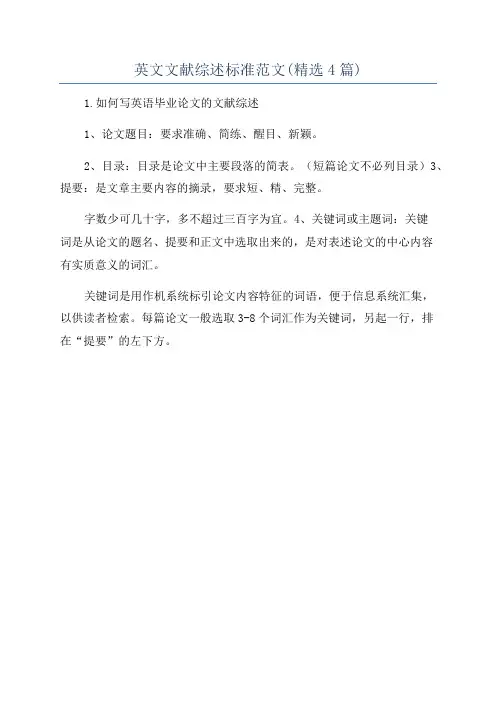
英文文献综述标准范文(精选4篇)
1.如何写英语毕业论文的文献综述
1、论文题目:要求准确、简练、醒目、新颖。
2、目录:目录是论文中主要段落的简表。
(短篇论文不必列目录)
3、提要:是文章主要内容的摘录,要求短、精、完整。
字数少可几十字,多不超过三百字为宜。
4、关键词或主题词:关键
词是从论文的题名、提要和正文中选取出来的,是对表述论文的中心内容
有实质意义的词汇。
关键词是用作机系统标引论文内容特征的词语,便于信息系统汇集,
以供读者检索。
每篇论文一般选取3-8个词汇作为关键词,另起一行,排
在“提要”的左下方。
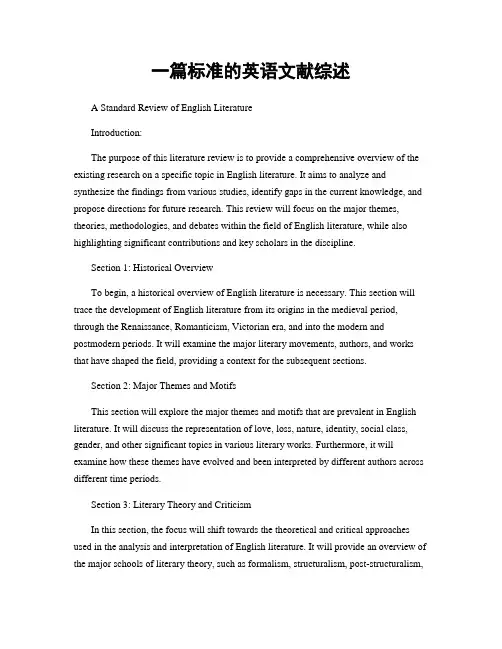
一篇标准的英语文献综述A Standard Review of English LiteratureIntroduction:The purpose of this literature review is to provide a comprehensive overview of the existing research on a specific topic in English literature. It aims to analyze and synthesize the findings from various studies, identify gaps in the current knowledge, and propose directions for future research. This review will focus on the major themes, theories, methodologies, and debates within the field of English literature, while also highlighting significant contributions and key scholars in the discipline.Section 1: Historical OverviewTo begin, a historical overview of English literature is necessary. This section will trace the development of English literature from its origins in the medieval period, through the Renaissance, Romanticism, Victorian era, and into the modern and postmodern periods. It will examine the major literary movements, authors, and works that have shaped the field, providing a context for the subsequent sections.Section 2: Major Themes and MotifsThis section will explore the major themes and motifs that are prevalent in English literature. It will discuss the representation of love, loss, nature, identity, social class, gender, and other significant topics in various literary works. Furthermore, it will examine how these themes have evolved and been interpreted by different authors across different time periods.Section 3: Literary Theory and CriticismIn this section, the focus will shift towards the theoretical and critical approaches used in the analysis and interpretation of English literature. It will provide an overview of the major schools of literary theory, such as formalism, structuralism, post-structuralism,feminist theory, and postcolonial theory, among others. The section will also discuss the contributions of key literary critics and their impact on the field.Section 4: Research MethodologiesTo understand the research process in English literature, this section will examine the various methodologies employed by scholars. It will discuss the use of close reading, intertextuality, comparative analysis, archival research, and other research methods in the field. The section will highlight the strengths and limitations of each methodology, providing insights into how researchers approach their studies.Section 5: Debates and ControversiesEnglish literature is not without its share of debates and controversies. This section will explore some of the ongoing discussions and disagreements within the field. It may include debates on the canon, the role of literature in society, the relevance of certain authors or works, and the influence of politics and ideology on literary analysis. The section will present different perspectives on these issues, showcasing the diversity of thought within English literature.Section 6: Significant Contributions and Key ScholarsFinally, this section will highlight some of the significant contributions made by scholars in the field of English literature. It will showcase the groundbreaking research, influential books, and key theories that have shaped the discipline. It will also acknowledge the scholars who have made significant contributions to the field and have become influential figures within English literature.Conclusion:In conclusion, this literature review has provided a comprehensive overview of the major themes, theories, methodologies, and debates within the field of English literature. It has traced the historical development of the discipline, explored the significant themes and motifs, discussed the theoretical and critical approaches, examined research methodologies, and highlighted ongoing debates and significant contributions. Thisreview serves as a valuable resource for researchers and scholars interested in the field of English literature, and it also lays the foundation for further research and exploration of the discipline.。
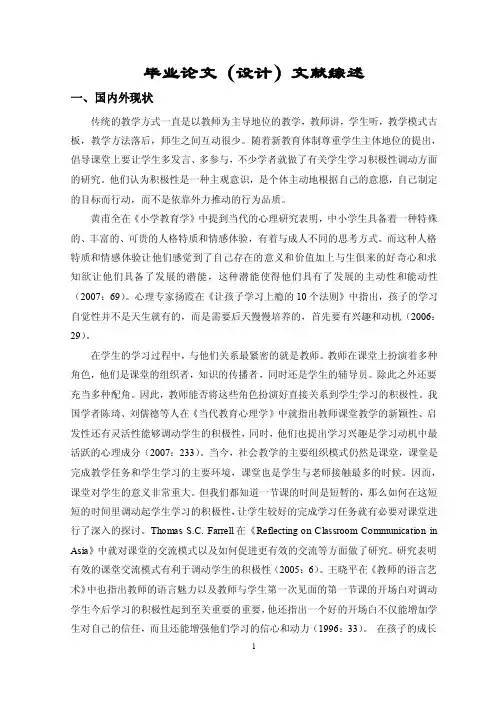
毕业论文(设计)文献综述一、国内外现状传统的教学方式一直是以教师为主导地位的教学,教师讲,学生听,教学模式古板,教学方法落后,师生之间互动很少。
随着新教育体制尊重学生主体地位的提出,倡导课堂上要让学生多发言、多参与,不少学者就做了有关学生学习积极性调动方面的研究。
他们认为积极性是一种主观意识,是个体主动地根据自己的意愿,自己制定的目标而行动,而不是依靠外力推动的行为品质。
黄甫全在《小学教育学》中提到当代的心理研究表明,中小学生具备着一种特殊的、丰富的、可贵的人格特质和情感体验,有着与成人不同的思考方式。
而这种人格特质和情感体验让他们感觉到了自己存在的意义和价值加上与生俱来的好奇心和求知欲让他们具备了发展的潜能,这种潜能使得他们具有了发展的主动性和能动性(2007:69)。
心理专家扬霞在《让孩子学习上瘾的10个法则》中指出,孩子的学习自觉性并不是天生就有的,而是需要后天慢慢培养的,首先要有兴趣和动机(2006:29)。
在学生的学习过程中,与他们关系最紧密的就是教师。
教师在课堂上扮演着多种角色,他们是课堂的组织者,知识的传播者,同时还是学生的辅导员。
除此之外还要充当多种配角。
因此,教师能否将这些角色扮演好直接关系到学生学习的积极性。
我国学者陈琦、刘儒德等人在《当代教育心理学》中就指出教师课堂教学的新颖性、启发性还有灵活性能够调动学生的积极性,同时,他们也提出学习兴趣是学习动机中最活跃的心理成分(2007:233)。
当今,社会教学的主要组织模式仍然是课堂,课堂是完成教学任务和学生学习的主要环境,课堂也是学生与老师接触最多的时候。
因而,课堂对学生的意义非常重大。
但我们都知道一节课的时间是短暂的,那么如何在这短短的时间里调动起学生学习的积极性,让学生较好的完成学习任务就有必要对课堂进行了深入的探讨。
Thomas S.C. Farrell在《Reflecting on Classroom Communication in Asia》中就对课堂的交流模式以及如何促进更有效的交流等方面做了研究。
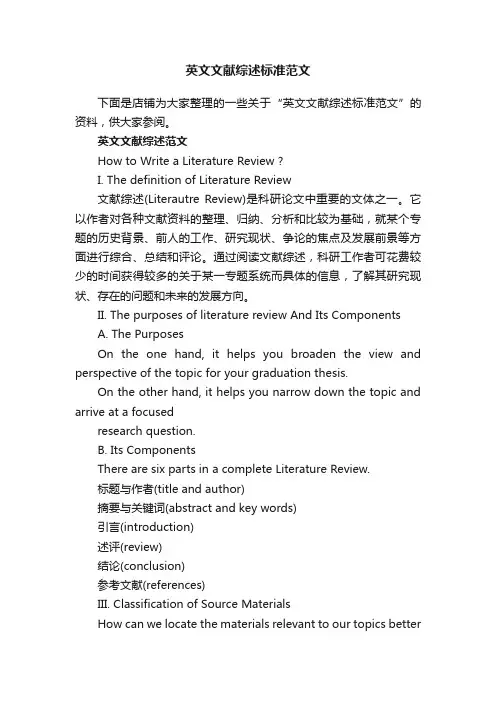
英文文献综述标准范文下面是店铺为大家整理的一些关于“英文文献综述标准范文”的资料,供大家参阅。
英文文献综述范文How to Write a Literature Review ?I. The definition of Literature Review文献综述(Literautre Review)是科研论文中重要的文体之一。
它以作者对各种文献资料的整理、归纳、分析和比较为基础,就某个专题的历史背景、前人的工作、研究现状、争论的焦点及发展前景等方面进行综合、总结和评论。
通过阅读文献综述,科研工作者可花费较少的时间获得较多的关于某一专题系统而具体的信息,了解其研究现状、存在的问题和未来的发展方向。
II. The purposes of literature review And Its ComponentsA. The PurposesOn the one hand, it helps you broaden the view and perspective of the topic for your graduation thesis.On the other hand, it helps you narrow down the topic and arrive at a focusedresearch question.B. Its ComponentsThere are six parts in a complete Literature Review.标题与作者(title and author)摘要与关键词(abstract and key words)引言(introduction)述评(review)结论(conclusion)参考文献(references)III. Classification of Source MaterialsHow can we locate the materials relevant to our topics betterand faster? Basically, all these source materials may be classified into four majors of sources.A: Background sources:Basic information which can usually be found in dictionaries andencyclopedia complied by major scholars or founders of the field. Three very good and commonly recommenced encyclopedias are encyclopedias ABC, namely, Encyclopedia Americana, Encyclopedia Britannica, and Collier’s Encyclopedia. There are also reference works more specialized, such as The Encyclopedia of Language and Linguistics for linguistics and TEFL studies. Moreover, you may also find Encyclopedia on the web.B: Primary sourcesThose providing direct evidence, such as works of scholars of the field,biographies or autobiographies, memoirs, speeches, lectures, diaries, collection of letters, interviews, case studies, approaches, etc. Primary sources come in various shapes and sizes, and often you have to do a little bit of research about the source to make sure you have correctly identified it. When a first search yields too few results, try searching by broader topic; when a search yields toomany results, refine your search by narrowing down your search.C: Secondary sourcesThose providing indirect evidence, such as research articles or papers, bookreviews, assays, journal articles by experts in a given field, studies on authors orwriters and their works, etc. Secondary sources will informmost of your writingin college. You will often be asked to research your topic using primary sources,but secondary sources will tell you which primary sources you should use andwill help you interpret those primary sources. T o use theme well, however, youneed to think critically them. There are two parts of a source that you need toanalyze: the text itself and the argument within the text.D: Web sourcesThe sources or information from websites. Web serves as an excellentresource for your materials. However, you need to select and evaluate Websources with special care for very often Web sources lack quality control. Youmay start with search engines, such as Google, Yahoo, Ask, Excit e, etc. It’s agood idea to try more than one search engine, since each locates sources in itsown way. When using websites for information, be sure to take care for theauthorship and sponsorship. If they are both unclear, be critical when you useinformation. The currency of website information should also be taken intoaccount. Don’t use too out information dated for your purpose.IV. Major strategies of Selecting Materials for literaturereviewA. Choosing primary sources rather than secondary sourcesIf you have two sources, one of them summarizing or explaining a work andthe other the work itself, choose the work itself. Never attempt to write a paperon a topic without reading the original source.B. Choosing sources that give a variety of viewpoints on your thesisRemember that good argument essays take into account counter arguments.Do not reject a source because it makes an argument against you thesis.C. Choosing sources that cover the topic in depthProbably most books on Communicative Language Teaching mention WilliamLittlewood, but if this your topic, you will find that few sources cover the topicin depth. Choose those.D. Choosing sources written by acknowledged expertsIf you have a choice between an article written by a freelance journalist onTask-based Teaching and one written by a recognized expert like David Nunan,Choose the article by the expert.E. Choosing the most current sourcesIf your topic involves a current issue or social problem or development in ascientific field, it is essential to find the latest possible information. If all thebooks on these topics are rather old, you probably need to look for information inperiodicals.V. Writing a literature ReviewA. When you review related literature, the major review focuses should be:1. The prevailing and current theories which underlie the research problem.2. The main controversies about the issue, and about the problem.3. The major findings in the area, by whom and when.4. The studies which can be considered the better ones, and why.5. Description of the types of research studies which can provide the basis for the current theories and controversies.6. Criticism of the work in the area.B. When you write literature review, the two principles to follow are:1. Review the sources that are most relevant to your to your thesis.2. Describe or write your review as clear and objective as you can.C. Some tips for writing the review:1. Define key terms or concepts clearly and relevant to your topic.2. Discuss the least-related references to your question first and the mostrelated references last.3. Conclude your review with a brief summary.4. Start writing your review early.VI. 文献综述主要部分的细节性提示和注意事项主要部分细节提示:引言(Introduction)引言是文献综述正文的开始部分,主要包括两个内容:一是提出问题;二是介绍综述的范围和内容。
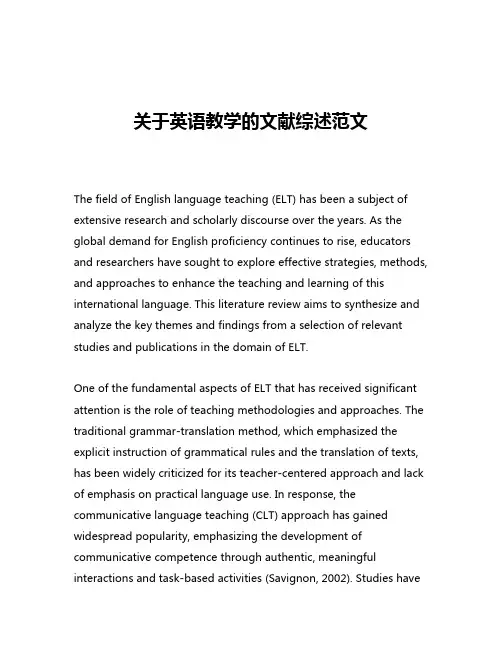
关于英语教学的文献综述范文The field of English language teaching (ELT) has been a subject of extensive research and scholarly discourse over the years. As the global demand for English proficiency continues to rise, educators and researchers have sought to explore effective strategies, methods, and approaches to enhance the teaching and learning of this international language. This literature review aims to synthesize and analyze the key themes and findings from a selection of relevant studies and publications in the domain of ELT.One of the fundamental aspects of ELT that has received significant attention is the role of teaching methodologies and approaches. The traditional grammar-translation method, which emphasized the explicit instruction of grammatical rules and the translation of texts, has been widely criticized for its teacher-centered approach and lack of emphasis on practical language use. In response, the communicative language teaching (CLT) approach has gained widespread popularity, emphasizing the development of communicative competence through authentic, meaningful interactions and task-based activities (Savignon, 2002). Studies haveshown that the CLT approach can lead to improved fluency, confidence, and overall language proficiency among language learners (Littlewood, 2014).Closely related to the discussion of teaching approaches is the concept of learner-centered instruction. Researchers have argued that effective ELT should prioritize the needs, interests, and learning styles of individual students, rather than adhering to a one-size-fits-all approach (Nunan, 1988). The incorporation of learner-centered strategies, such as differentiated instruction, project-based learning, and the use of technology-assisted language learning, has been found to enhance student motivation, engagement, and overall language development (Tomlinson, 2014).Another important area of focus in ELT research is the role of technology in language teaching and learning. The rapid advancements in digital technologies have significantly impacted the field of ELT, opening up new possibilities for language instruction and practice. Studies have explored the integration of various technological tools, such as online language learning platforms, mobile applications, and virtual classrooms, and their potential to improve language skills, enhance learner autonomy, and provide personalized feedback (Chapelle & Sauro, 2017).The issue of language assessment has also been a subject ofextensive research in ELT. Scholars have examined the effectiveness of different assessment methods, including formative and summative assessments, as well as the use of standardized language proficiency tests, such as the TOEFL and IELTS (Fulcher & Davidson, 2007). The importance of aligning assessment practices with the desired learning outcomes and the implementation of alternative assessment strategies, such as portfolio-based assessment and performance-based tasks, have been highlighted in the literature.The cultural and linguistic diversity of language learners is another crucial factor that has been widely discussed in ELT research. Scholars have emphasized the need to incorporate culturally responsive teaching practices, which acknowledge and validate the diverse backgrounds and experiences of language learners, and promote intercultural understanding and sensitivity (Canagarajah, 2005). Additionally, the role of the learners' first language (L1) in the ELT process has been a topic of debate, with some studies suggesting that judicious use of L1 can facilitate language learning, while others advocate for a more exclusive use of the target language (Cook, 2001).Finally, the professional development of ELT practitioners has been a crucial area of concern. Researchers have highlighted the importance of ongoing teacher training, collaboration, and the integration of research-informed practices to ensure the continuous improvementof teaching quality and student learning outcomes (Richards & Farrell, 2005). The exploration of teacher beliefs, attitudes, and reflective practices has also been a significant focus in ELT literature.In conclusion, this literature review has provided a comprehensive overview of the key themes and trends in the field of English language teaching. The findings from the various studies and publications discussed here underscore the complexity and multifaceted nature of ELT, as well as the need for a dynamic and evidence-based approach to language instruction. As the field continues to evolve, future research should explore emerging pedagogical strategies, technological advancements, and the changing needs and expectations of language learners in an increasingly globalized world.。
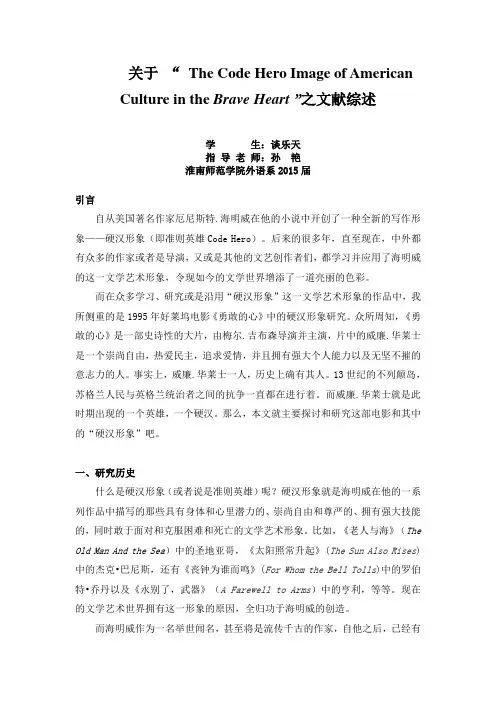
关于“The Code Hero Image of AmericanCulture in the Brave Heart ”之文献综述学生:谈乐天指导老师:孙艳淮南师范学院外语系2015届引言自从美国著名作家厄尼斯特.海明威在他的小说中开创了一种全新的写作形象——硬汉形象(即准则英雄Code Hero)。
后来的很多年,直至现在,中外都有众多的作家或者是导演,又或是其他的文艺创作者们,都学习并应用了海明威的这一文学艺术形象,令现如今的文学世界增添了一道亮丽的色彩。
而在众多学习、研究或是沿用“硬汉形象”这一文学艺术形象的作品中,我所侧重的是1995年好莱坞电影《勇敢的心》中的硬汉形象研究。
众所周知,《勇敢的心》是一部史诗性的大片,由梅尔.吉布森导演并主演,片中的威廉.华莱士是一个崇尚自由,热爱民主,追求爱情,并且拥有强大个人能力以及无坚不摧的意志力的人。
事实上,威廉.华莱士一人,历史上确有其人。
13世纪的不列颠岛,苏格兰人民与英格兰统治者之间的抗争一直都在进行着。
而威廉.华莱士就是此时期出现的一个英雄,一个硬汉。
那么,本文就主要探讨和研究这部电影和其中的“硬汉形象”吧。
一、研究历史什么是硬汉形象(或者说是准则英雄)呢?硬汉形象就是海明威在他的一系列作品中描写的那些具有身体和心里潜力的、崇尚自由和尊严的、拥有强大技能的,同时敢于面对和克服困难和死亡的文学艺术形象。
比如,《老人与海》(The Old Man And the Sea)中的圣地亚哥,《太阳照常升起》(The Sun Also Rises)中的杰克•巴尼斯,还有《丧钟为谁而鸣》(For Whom the Bell Tolls)中的罗伯特•乔丹以及《永别了,武器》(A Farewell to Arms)中的亨利,等等。
现在的文学艺术世界拥有这一形象的原因,全归功于海明威的创造。
而海明威作为一名举世闻名,甚至将是流传千古的作家,自他之后,已经有很多中外的学者专家们把研究的对象转向了他,同样转向了由他开创的“硬汉形象”。
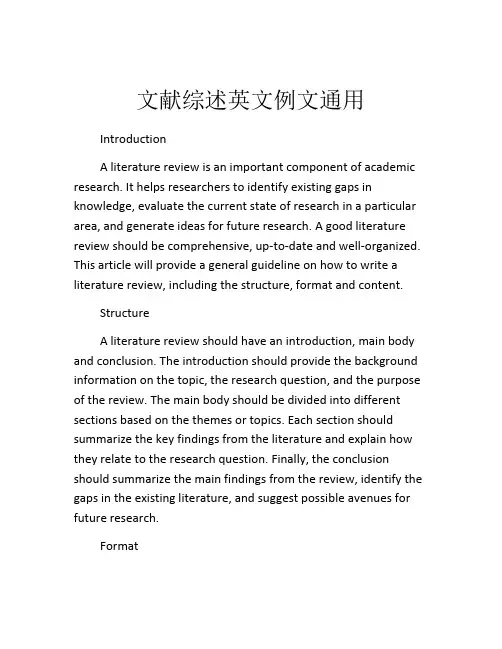
文献综述英文例文通用IntroductionA literature review is an important component of academic research. It helps researchers to identify existing gaps in knowledge, evaluate the current state of research in a particular area, and generate ideas for future research. A good literature review should be comprehensive, up-to-date and well-organized. This article will provide a general guideline on how to write a literature review, including the structure, format and content.StructureA literature review should have an introduction, main body and conclusion. The introduction should provide the background information on the topic, the research question, and the purpose of the review. The main body should be divided into different sections based on the themes or topics. Each section should summarize the key findings from the literature and explain how they relate to the research question. Finally, the conclusion should summarize the main findings from the review, identify the gaps in the existing literature, and suggest possible avenues for future research.FormatA literature review can be written in different formats depending on the discipline and the research topic. In general, there are two common formats: the narrative review and the systematic review. The narrative review is a descriptive summary of the literature, whereas the systematic review is a more rigorous evaluation of the literature using a predefined search strategy and inclusion/exclusion criteria.ContentThe content of a literature review should be focused on the research question and the themes identified in the main body. The literature reviewed should be relevant, reliable, and recent. The sources of the literature can be primary or secondary, depending on the research question and the availability of the literature. The sources can be in different forms, such as articles, books, reports, conference proceedings, and online databases.TipsHere are some tips on how to write a good literature review:- Start early: Begin the literature review as early as possible to allow sufficient time for reading, writing, and revising.- Define the research question: Clearly define the research question to guide the literature search and the selection of the literature.- Use appropriate keywords: Use appropriate keywords and search terms to identify the relevant literature.- Keep records: Keep a record of the literature searched, read and cited to avoidduplication and facilitate referencing.- Analyze and synthesize: Analyze the literature critically and synthesize the findings into a coherent and organized structure.- Avoid plagiarism: Acknowledge the sources of the literature accurately and avoid plagiarism by paraphrasing and referencing properly.- Be critical: Be critical of the literature reviewed and identify the strengths, weaknesses, and limitations of the research in the field.ConclusionIn summary, a literature review is an essential component of academic research, and it requires careful planning, organizing, and writing. A good literature review should provide a comprehensive and critical evaluation of the existing literature and identify the gaps and limitations in the research field. By following the guidelines and tips provided in this article, researchers can write a well-structured, informative and engaging literature review.。
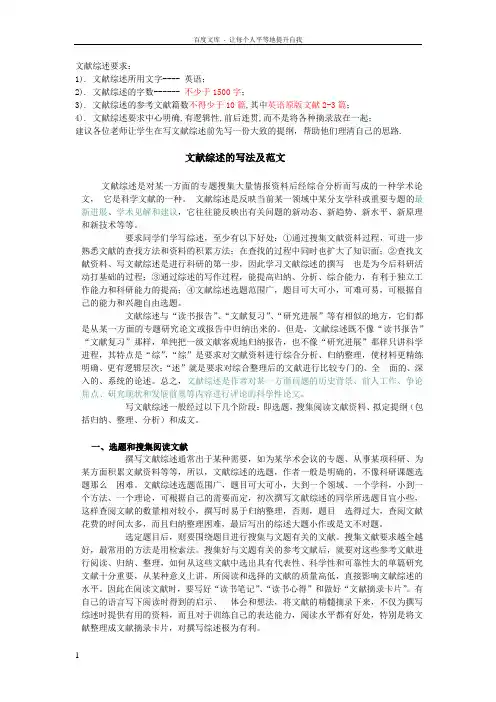
文献综述要求:1). 文献综述所用文字---- 英语;2). 文献综述的字数------ 不少于1500字;3). 文献综述的参考文献篇数不得少于10篇,其中英语原版文献2-3篇;4). 文献综述要求中心明确,有逻辑性,前后连贯,而不是将各种摘录放在一起;建议各位老师让学生在写文献综述前先写一份大致的提纲,帮助他们理清自己的思路.文献综述的写法及范文文献综述是对某一方面的专题搜集大量情报资料后经综合分析而写成的一种学术论文,它是科学文献的一种。
文献综述是反映当前某一领域中某分支学科或重要专题的最新进展、学术见解和建议,它往往能反映出有关问题的新动态、新趋势、新水平、新原理和新技术等等。
要求同学们学写综述,至少有以下好处:①通过搜集文献资料过程,可进一步熟悉文献的查找方法和资料的积累方法;在查找的过程中同时也扩大了知识面;②查找文献资料、写文献综述是进行科研的第一步,因此学习文献综述的撰写也是为今后科研活动打基础的过程;③通过综述的写作过程,能提高归纳、分析、综合能力,有利于独立工作能力和科研能力的提高;④文献综述选题范围广,题目可大可小,可难可易,可根据自己的能力和兴趣自由选题。
文献综述与“读书报告”、“文献复习”、“研究进展”等有相似的地方,它们都是从某一方面的专题研究论文或报告中归纳出来的。
但是,文献综述既不像“读书报告”“文献复习”那样,单纯把一级文献客观地归纳报告,也不像“研究进展”那样只讲科学进程,其特点是“综”,“综”是要求对文献资料进行综合分析、归纳整理,使材料更精练明确、更有逻辑层次;“述”就是要求对综合整理后的文献进行比较专门的、全面的、深入的、系统的论述。
总之,文献综述是作者对某一方面问题的历史背景、前人工作、争论焦点、研究现状和发展前景等内容进行评论的科学性论文。
写文献综述一般经过以下几个阶段:即选题,搜集阅读文献资料、拟定提纲(包括归纳、整理、分析)和成文。
一、选题和搜集阅读文献撰写文献综述通常出于某种需要,如为某学术会议的专题、从事某项科研、为某方面积累文献资料等等,所以,文献综述的选题,作者一般是明确的,不像科研课题选题那么困难。
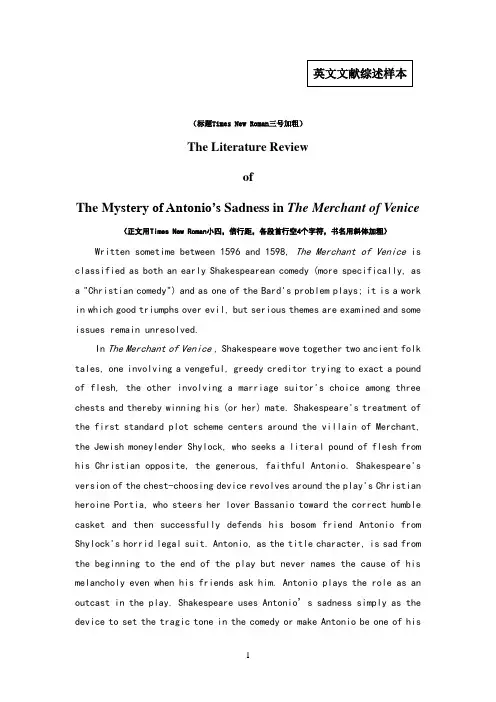
(标题Times New Roman三号加粗)The Literature ReviewofThe M ystery of Antonio’s Sadness in The Merchant of Venice (正文用Times New Roman小四,倍行距,各段首行空4个字符,书名用斜体加粗)Written sometime between 1596 and 1598, The Merchant of Venice is classified as both an early Shakespearean comedy (more specifically, as a "Christian comedy") and as one of the Bard's problem plays; it is a work in which good triumphs over evil, but serious themes are examined and some issues remain unresolved.In The Merchant of Venice, Shakespeare wove together two ancient folk tales, one involving a vengeful, greedy creditor trying to exact a pound of flesh, the other involving a marriage suitor's choice among three chests and thereby winning his (or her) mate. Shakespeare's treatment of the first standard plot scheme centers around the villain of Merchant, the Jewish moneylender Shylock, who seeks a literal pound of flesh from his Christian opposite, the generous, faithful Antonio. Shakespeare's version of the chest-choosing device revolves around the play's Christian heroine Portia, who steers her lover Bassanio toward the correct humble casket and then successfully defends his bosom friend Antonio from Shylock's horrid legal suit. Antonio, as the title character, is sad from the beginning to the end of the play but never names the cause of his melancholy even when his friends ask him. Antonio plays the role as an outcast in the play. Shakespeare uses Antonio’s sadness simply as the device to set the tragic tone in the comedy or make Antonio be one of hismelancholic characters in his works Or Antonio is the representative of the complicated human nature Antonio's unexplained melancholy is a significant element in understanding the play.1. Studies on The Merchant of Venice(Times New Roman + 四号 +首缩进4字符,下同)Karl Marx once cited that Shakespeare is the greatest playwright in the world. Shakespeare’s comedy The Merchant of Venice is one of the most influential comedies in his works. Shylock has mostly been the center of the research on the play.The Merchant of Venice was first printed in 1600 in quarto, of which nineteen copies survive. This was followed by a 1619 printing, and later an inclusion in the First Folio in 1623. The play was written shortly after Christopher Marlowe’s imme nsely popular Jew of Malta(1589), a play wherein a Jew named Barabas plays a greatly exaggerated villain. The portrayal of Shakespeare's Jew was and remained comic until the late 1700s at which time he was first played as a true villain. In 1814 Shylock’s role was depicted as a character to be pitied, and in 1879 he was first portrayed as a tragic character. Subsequent interpretations have varied greatly over the years, but since World War II he has most often been conceived of as tragic. The Merchant of Venice has been described as a great commentary on the nature of racial and religious interactions.2. Deficiencies of Previous Studies on the Mystery of Antonio’s Sadness in The Merchant of VeniceThe title character, Antonio, begins the play intriguingly: "In sooth, I know not why I am so sad; / It wearies me" Much ink has been spilled with conjectures about Antonio's melancholy: that he's simply melancholic of temperament, that his devotion to Bassanio is homoerotic and the news that this friend seeks to marry has depressed him (Antonio is a nameShakespeare uses also in Twelfth Night for a character with an intense devotion to another male), or that he has an "ominous foreboding" about the events that will transpire in the course of this play. Although those pioneers aroused people to think much of The Merchant of Venice and left us invaluable and systematic reference, and made many achievements in description and explanation of the cause of Antonio’s sadness, there remain many deficiencies.First, The Merchant of Venice, which is considered to be one of Shakespeare’s four great comedies,actually functions as Shakespeare's farewell to comedy. Antonio is one of Shakespeare’s melancholic characters. Shakespeare in The Merchant of Venice is undermining all that passes for comic entertainment. Shakespeare uses Antonio’s sadness as a device to set the tragic tone in the comic atmosphere.Second, a lot of issues that are argued about regarding The Merchant of Venice can be considerably clarified if we know something about the audience it was written for.In the modern, post-Holocaust readings of the play, the problem of anti-Semitism in the play has been discussed a lot. Given that Antonio decides not to seize Shylock’s goods as punishment, we might consider Antonio to be merciful. But we may also question whether it is merciful to return to Shylock half of his goods, only to take away his religion and his profession. Antonio’s compassion seems to stem as much from self-interest as from concern for his fellow man. Shakespeare thus shows a balance of prejudice on both sides. The question whether Antonio is a homosexual in love with Bassanio can also interpreted differently.5. ConclusionDespite the researches already done and achievements already made onthe subject, many frontiers are still waiting to be explored. On the basis of the previous researches by forerunners and adopting new approaches we are to make a deeper and more comprehensive understanding of this subject. We don't mean to suggest that other ways of looking at the play are "wrong." In fact, one of the things that is so great about Shakespeare is that there are so many different ways of interpreting his plays that all work.References (Times New Roman四号加粗)参考文献不应少于10条,参考文献应按英文26个字母的顺序排列,先列外文文献后列中文文献,中文用宋体小四,外文用Times New Roman小四。
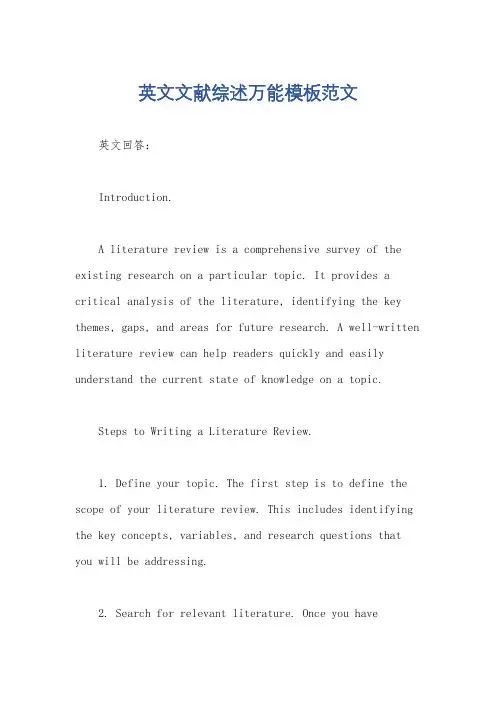
英文文献综述万能模板范文英文回答:Introduction.A literature review is a comprehensive survey of the existing research on a particular topic. It provides a critical analysis of the literature, identifying the key themes, gaps, and areas for future research. A well-written literature review can help readers quickly and easily understand the current state of knowledge on a topic.Steps to Writing a Literature Review.1. Define your topic. The first step is to define the scope of your literature review. This includes identifying the key concepts, variables, and research questions that you will be addressing.2. Search for relevant literature. Once you havedefined your topic, you need to search for relevant literature. This can be done through a variety of sources, including academic databases, Google Scholar, and library catalogs.3. Evaluate the literature. Once you have found a bodyof literature, you need to evaluate it to determine its relevance, quality, and credibility. This involves reading the abstracts and full text of the articles and assessing their strengths and weaknesses.4. Organize your review. Once you have evaluated the literature, you need to organize it into a logical structure. This may involve grouping the articles by theme, methodology, or research question.5. Write your review. The final step is to write your literature review. This should include a clear introduction, a body that discusses the key findings of the literature, and a conclusion that summarizes your findings andidentifies areas for future research.Tips for Writing a Literature Review.Be comprehensive. Include all of the relevant literature on your topic, even if it is not supportive of your hypothesis.Be critical. Evaluate the strengths and weaknesses of the literature, and identify any gaps in the research.Be clear and concise. Write in a clear and concise style, and avoid using jargon or technical language.Proofread carefully. Make sure to proofread your literature review carefully before submitting it.中文回答:文献综述的撰写步骤。
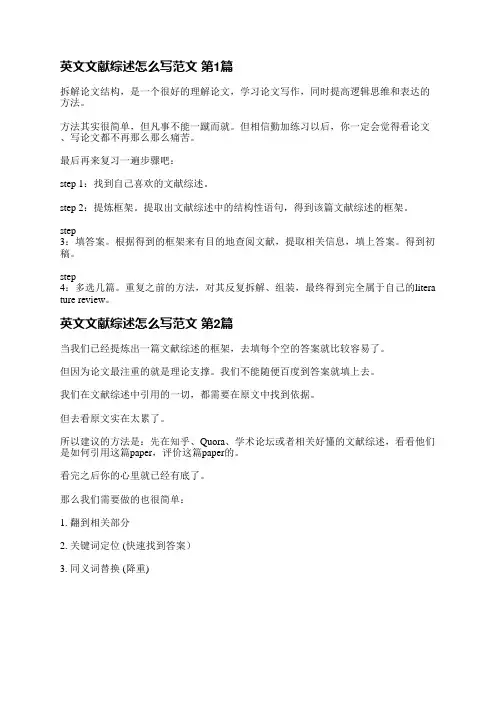
拆解论文结构,是一个很好的理解论文,学习论文写作,同时提高逻辑思维和表达的方法。
方法其实很简单,但凡事不能一蹴而就。
但相信勤加练习以后,你一定会觉得看论文、写论文都不再那么那么痛苦。
最后再来复习一遍步骤吧:step 1:找到自己喜欢的文献综述。
step 2:提炼框架。
提取出文献综述中的结构性语句,得到该篇文献综述的框架。
step3:填答案。
根据得到的框架来有目的地查阅文献,提取相关信息,填上答案。
得到初稿。
step4:多选几篇。
重复之前的方法,对其反复拆解、组装,最终得到完全属于自己的litera ture review。
英文文献综述怎么写范文第2篇当我们已经提炼出一篇文献综述的框架,去填每个空的答案就比较容易了。
但因为论文最注重的就是理论支撑。
我们不能随便百度到答案就填上去。
我们在文献综述中引用的一切,都需要在原文中找到依据。
但去看原文实在太累了。
所以建议的方法是:先在知乎、Quora、学术论坛或者相关好懂的文献综述,看看他们是如何引用这篇paper,评价这篇paper的。
看完之后你的心里就已经有底了。
那么我们需要做的也很简单:1. 翻到相关部分2. 关键词定位 (快速找到答案)3. 同义词替换 (降重)文献综述是一种通过对已有文献进行梳理、分析和评价的方法,以形成系统性的综合性文献报告,探讨某个问题的现状、发展趋势以及未来研究方向的方法。
那么如何写优秀的文献综述呢?下面从几个角度为大家介绍。
1.明确研究目的和问题在写文献综述之前,先要明确自己的研究目的和问题,这有助于你在文献中寻找和汇总符合研究方向的文献资料,也能避免收集到不必要的资料浪费时间。
2.合理筛选文献来源3.分类整理文献资料在文献综述的写作过程中,需要将搜集到的文献进行分类整理,例如按照时间、地区、专业领域、研究角度等进行整合,方便后续的分析和总结。
4.分析比较文献中不同观点和研究方法通过对文献的比较和分析,可以了解研究领域发展的趋势、发现未解决的问题和矛盾,并提出自己的新的解决方法,这就需要作家具有较强的综合分析能力。
Literature review of reading issuesIntroduction:Reading is regarded as the one of the four basic skills l in language learning because people get information through reading as well as listening rather than speaking and writing。
Barnes &Powell think th at “Reading holds the key to advanced language learning.” (1996, p。
13) Krashen’s input hypothesis (1982) also provided the theoretical support reading in second or foreign language acquisition which argues for the learners acquire a language by enough and high—quality comprehensible input。
The development of technology like faxes, computers makes reading more important in daily life and language learning or acquisition. However,the widespread of Communicative Language Teaching nowadays avert more of educat or’s attention from reading to speaking all over the world,particularly in Asian countries like China whereas reading comprehension is the most important and necessary part in all English exams。
经典英文文献综述范文English:A classic English literature review typically provides an overview and analysis of key works in a particular field or topic. It often begins with an introduction that outlines the scope and purpose of the review, followed by a discussion of the historical context and the evolutionof the topic. The literature review then delves into a detailed examination of the most influential and significant texts, identifying key themes, arguments, and methodologies employed by the authors. The review also seeks to identify gaps or unresolved issuesin the existing research, and may propose avenues for future exploration in the field. This type of literature review is valuable for scholars and researchers seeking to gain a comprehensive understanding of the state of knowledge in their area of study, and often serves as a foundation for new research projects and critical debates within the academic community.中文翻译:经典的英文文献综述通常提供了一个特定领域或主题关键作品的概述和分析。
Title: English Literature Review: AComprehensive PerspectiveIn the realm of academic research, the literature review serves as a critical component, particularly in the field of English literature. This paper aims to provide an extensive overview of the significant developments and trends within the discipline, drawing upon a diverse range of sources and perspectives.Firstly, it is essential to recognize the evolving nature of English literature, which has been shaped by various historical, cultural, and societal influences. The early works of Shakespeare, for instance, have been extensively analyzed for their thematic depth andlinguistic intricacies. Modern scholars continue to delve into these classics, offering fresh interpretations that resonate with contemporary audiences.Moreover, the emergence of new literary genres and movements has significantly broadened the scope of English literature. Postmodernism, for example, has challenged traditional narrative structures and perspectives, introducing elements of ambiguity and fragmentation. Thistrend has been explored in numerous studies, highlighting the diverse ways in which authors have responded to and shaped the postmodern era.Furthermore, the intersection of English literature with other disciplines, such as psychology, sociology, and anthropology, has opened up new avenues for research. The exploration of character psychology in literary texts, or the analysis of societal norms and values reflected in literature, are just a few examples of thisinterdisciplinary approach.In terms of methodologies, the literature review has also undergone significant transformations. With the advent of digital technologies and online databases, scholars now have access to vast repositories of information, enabling them to conduct more comprehensive and rigorous reviews. However, the challenge lies in effectively synthesizing and evaluating this vast amount of data.One notable trend in recent years has been the increasing focus on global perspectives in English literature. With the growth of international literary movements and the rise of multiculturalism, scholars arenow more inclined to explore the global dimensions of literary works. This approach not only broadens our understanding of English literature but also promotes cross-cultural understanding and exchange.Moreover, the impact of gender and race on English literature has also been a topic of increasing interest. The examination of how gender roles and racial identities are represented and constructed in literary texts has provided valuable insights into the complex intersections of identity, power, and representation.In conclusion, the literature review in English literature is a dynamic and evolving field that continues to shape our understanding of the discipline. By exploring diverse themes, genres, and methodologies, scholars are able to delve deeper into the rich tapestry of English literature, revealing new meanings and perspectives that resonate with our contemporary world.**英语文献综述:全面视角**在学术研究领域,文献综述是一个至关重要的组成部分,尤其在英语文学领域更是如此。
英语专业本科毕业论文文献综述示例(英文)Literature Review— The Qu est for Meaning of Life in Mrs. Dalloway论《达罗卫夫人》对生命意义的探求ranks as one of most distinguished writers. Mrs. Dalloway (1925), To the Lighthouse(1927), and Jacob's Room (1922) are Virginia Woolf's representative novels. She1. Stream of consciousness, modernism, realismIn Mrs. Dalloway, Woolf successfully explores stream ofconsciousness. She2.PhilosophyWoolf’s aesthetic and philosophical attitude was greatly influenced by the Cambridge philosopher G. E. Moore’s theory which greatly influencedall members of3. Psychoanalysis, the relation with Sigmund FreudNicole Jouve in Virginia Woolf and psychoanalysis to psychoanalysis was in three ways:4. Poetic feature, such a s from the word of ‘plunge’Mary Hughes in The Plunge in Mrs. Dalloway and the Book to Comeillustrates Clarissa embrace the life through explaining the word“plunge”, and points out5. The theme of life and deathLiterary criticism in China mainly focuses on the writing techniques usedin the novel, but Cheng Yan-qin and Xu Hong-zhen talk about andCoercion in Virginia Woolf’s Mrs. Dalloway”, Women’s Vision in Western Literature: the empathic community.Westport: Praeger Publishers, 2005.(至少10篇以上,期中英文至少5篇)注:所谓文献综述就是根据所收集到的与论文相关的文献在文内列出若干个小标题,然后根据小标题展开综述。
英语专业毕业论文文献综述样例参考范文1Distance LearningThis paper will summarize two articles on distance learning and give the author‟s views on the benefits and obstacles of implementing distance-learning in a junior and senior high school learning environment.Jeannette McDonald, in her article: Is “As good as face-to-face” as good as it gets? (2002), raises a very important question as to whether “[the] goal [of online learning should be] to meet existing standards of traditional education”(McDonald, 2002) or “has distance learning, and especially online education opened the door to enhanced strategies in teaching and learning”(McDonald, 2002)? Online learning may just be “doing different things”(McDonald, 2002). What are these different things? Jeannette McDonald claims that “distance education can be a frontier for new methods of communication giving rise to innovative teaching and learning practices that may not be possible in traditional, place-bound education”(2002). The article discusses both the positive and “potential negative impacts of online education”(McDonald, 2002).There are many benefits to using online distance learning environments. Online education is available “anyplace, anytime [for] global communities of lea rners based on shared interests”(McDonald, 2002). Jeannette McDonald claims that “online education [with its] group-based instruction [and] computer mediated communication (CMC) provides an opportunity for new development and understanding in teaching and learning”(2002). CMC encourages “collaborative learning [by not providing] cues regarding appearance, race, gender, education, or social status bestowing a sort of anonymity to participants”(McDonald, 2002). Distance also “permits the expression of emotion (both positive and negative) and promotes discussion that normally would be inhibited. [Y et, this same] text-based [positive aspect of online learning], makes online education more cumbersome and therefore takes more time than face-to-face learning. [In addition,] the sheer bulk of messages can be overwhelming”(McDonald, 2002). The learner only has the written text and no other “non-verbal”(McDonald, 2002) cues. This may confuse the learner and cause “misunderstanding” (McDonald, 2002). The article lists the “seven principles of good practice in undergraduate education” (McDonald, 2004) published in 1987 by the American Association of Higher Education Bulletin. Jeannette McDonald claims that “online education has the potential to achiever all of these practices” (2002). There is a need for quality and standards for distance learning. “In April 2000, the institute of Higher Education Policy produced a study with 24 benchmarks for the success in Internet-based distance education” (The Institute for Higher Education Policy, 2000).Although Jeannette McDonald feels that there are “biases against distance learning programs” (2002), her recommendation is “to take advantage of the potential of online education [by striving] to understand the technology and how it affects human communication and interaction” (2002).“In the road to dotcom in education”(2004), Mark David Milliron deals with a very progressive idea that suggests educators “slow … down from [their] busy lives… to be free to focus first on connecting with learners and connecting them to learning … before [they] end up feeling like [they] are no longer using technology, but are being used by it” (Milliron, 2004). He compares education to a highway where educators are faced with many “road hazards”. MarkMilliron claims that “looking for road hazards on a journey takes concentration [which] is not often practiced by those with a need for speed or those caught up in their competitive drives”(2004). He gives examples of how ridiculous people are becoming when they “strive to stay connected [to cell phones and e-mails at the price of] deep personal connections with [their] family members and friends” (Milliron, 2004). He quotes Dr. Edward Hallowell, who ironically states “how many electronic connections we have today, yet how hard it is for us to form authentic and deep personal connections”(Milliron, 2004). Mark Milliron gives an excellent comparison of how technology has blinded people when he says that they are becoming “more and more like Pavlov‟s dogs: at the ding of incoming e-mails they stop what they‟re doing, salivate, and rush to the screen” (2004). There is pressure to keep up with the times as well as “a cost-of-entry issue regarding technology in education. Without a certain level of technology services and learning options, many students will not consider attending [a certain] institution”(Milliron, 2004). Mark Milliron claims that “any technology has to prove that it will ultimately improve or expand learning” (2004). This will come about if educators “slow down, look around, and get on the road to DotCalm- a place [to] thoughtfully engage and explore all aspects of technology, good, bad, or indifferent; …a place with mindful focus on the people and passions that make life worth living” (Milliron, 2004).The author of this paper has been trying to implement distance learning in both junior and high school environments for the past year. The school has added a platform called “Britannica”to make online learning possible in case of emergency or a teacher‟s strike. The students are not willing to take the time to go in and look up homework assignments and other online learning activities. The author keeps reminding students to add their e-mail addresses to the form but they are unwilling to cooperate. The process is very slow with little results. Some teachers have made these online lessons compulsory for their students. ESL students shy away from online classes. They have expressed fear of having their work viewed by others. Every student has to login to the school site but within a classroom, everyone who takes the class can view the other‟s work. ESL students don‟t see the advantage of learning by sharing. Should online learning be an issue of control or should students be convinced of its value as an authentic learning tool? Fear and a threatening environment don‟t enhance learning according to brain-based learning research. “How students …feel‟ about a learning situation determines the amount of attention they devote to it”(Sousa, 1998). “Positive emotions ensure that learning will be retained” (Lackney, 2002). It‟s very important to discuss with students how they feel about technology and online learning so that they feel good about what they are doing. The author feels that the process of implementing online distance learning is a slow and delicate one. Change will eventually come about but it will take time. As Mark Milliron has said “[let‟s not let] new technology … get in the way of learning” (2004). Let‟s calm down as we “focus first on connecting with learners [and only then begin] connecting them to learning” (Milliron, 2004).参考范文2 Language and GenderWith the general growth of feminist work in many academic fields, it is hardly surprising that the relationship between language and gender has attracted considerable attention in recent years. In an attempt to go beyond “folk linguistic” assumptions about how men and women use language (the assumption that women are “talkative”, for example), studies have focused on anything from different syntactical, phonological or lexical uses of language to aspects of conversation analysis, such as topic nomination and control, interruptions and other interact ionalfeatures. While some research has focused only on the description of differences, other work has sought to show how linguistic differences both reflect and reproduce social difference. Accordingly, Coates (1988) suggests that research on language and gender can be divided into studies that focus on dominance and those that focus on difference.Much of the earlier work emphasized dominance. Lakoff‟s (1975) pioneering work suggested that women‟s speech typically displayed a range of features, such as tag questions, which marked it as inferior and weak. Thus, she argued that the type of subordinate speech learned by a young girl “will later be an excuse others use to keep her in a demeaning position, to refuse to treat her seriously as a human being”(1975, p.5). While there are clearly some problems with Lakoff‟s work - her analysis was not based on empirical research, for example, and the automatic equation of subordinate with …weak‟is problemati c-the emphasis on dominance has understandably remained at the centre of much of this work. Research has shown how men nominated topics more, interrupted more often, held the floor for longer, and so on (see, for example, Zimmerman and West, 1975). The chief focus of this approach, then, has been to show how patterns of interaction between men and women reflect the dominant position of men in society.Some studies, however, have taken a different approach by looking not so much at power in mixed-sex interactions as at how same-sex groups produce certain types of interaction. In a typical study of this type, Maltz and Borker (1982) developed lists of what they described as men‟s and women's features of language. They argued that these norms of interaction were acquired in same-sex groups rather than mixed-sex groups and that the issue is therefore one of (sub-)cultural miscommunication rather than social inequality. Much of this research has focused on comparisons between, for example, the competitive conversational style of men and the cooperative conversational style of women.While some of the more popular work of this type, such as Tannen (1987), lacks a critical dimension, the emphasis on difference has nevertheless been valuable in fostering research into gender subgroup interactions and in em phasizing the need to see women‟s language use not only as …subordinate‟ but also as a significant sub-cultural domain.Although Coates‟ (1988) distinction is clearly a useful one, it also seems evident that these two approaches are by no means mutually exclusive. While it is important on the one hand, therefore, not to operate with a simplistic version of power and to consider language and gender only in mixed-group dynamics, it is also important not to treat women‟s linguistic behavior as if it existed outside social relations of pow er. As Cameron, McAlinden and O‟Leary (1988) ask, “Can it be coincidence that men are aggressive and hierarchically-organized conversationalists, whereas women are expected to provide conversational support?” (p.80). Clearly, there is scope here for a great deal more research that is based on empirical data of men‟s and women‟s speech; operates with a complex understanding of power and gender relationships (so that women‟s silence, for example, can be seen both as a site of oppression and as a site of possible resistance); looks specifically at the contexts of language use, rather than assuming broad gendered differences; involves more work by men on language and gender, since attempts to understand male uses of language in terms of difference have been few (thus running the danger of constructing men‟s speech as the …norm‟ and women‟s speech as …different‟); aims not only to describe and explain but also to change language and social relationships.。
英语专业文献综述Outline(5篇)第一篇:英语专业文献综述OutlineOutline 1 Introduction 2 Literature overreview2.1 Peer review2.2 incidental vocabulary acquisition2.3 Peer evaluation and the teacher3 Design of the study4 Results4.1 Students as evaluatees4.2 Students as evaluators5 Discussion6 Conclusion第二篇:英语专业实习报告 intership report outlineOutline for Internship Report1.First PageFirst page should display: Student name and surname, internship start and finish dates, number of internship days, type of internship(production, or design and development), company/institution name.This page should be signed and stamped by the supervisor of the intern student.2.Weekly timetableA weekly timetable where each row in the table corresponding to a day in internship period.Each row should record the date, internship activity on that date.Weekly Schedule should explain the work accomplished each day of the week during the internship period and should contain:•••The department of the organization that the week was and signature of the controlling supervisor for each week The official stamp of the organization.3.A Brief Executive Summary of the InternshipA one page summary of the company/institution and a short account of the major activities carried out during the internship period.4.Table of ContentsContents of the report with page numbers, list of tables, and list of figures.5.Description of the company/institution This section should answer the following questions:5.1.What is the full title of the company/institution? Give a brief history of the company, fullmailing address and relevant web links.5.2.What is the type of ownership of the company/institution? State the main shareholders andtheir shares.5.3.What is the sector that the company/institution operates in? Specify the products and servicesproduced and offered to its customers.5.4.Who are regarded as the customers of your internship company/institution(consider the endusers, retailers, other manufacturers, employees, etc.)?5.5.Provide an organization chart of the company, along with information on the number ofemployees.5.6.Provide a list of functions performed by the mechanical engineers in the internshiporganization.6.Internship activitiesThis is the main body of your report.You should present the activities performed during the internship period.Please refer to “” document for the types of analysis and inquiries that you should be perfo rming during “Production”, and “Design and Development” internship.7.An assessment of the internship In this section you should answer the following questions7.1.What skills and qualifications you think that you havegained from the internship?7.2.What kind of responsibilities you have undertaken during the internship period?7.3.How do you think the internship will influence your future career plans?7.4.How do you think the internship activities that you carried out are correlated with yourclassroom knowledge?8.Conclusions of the reportThis section should include:• A summary of key conclusions derived from the internship experience.• General observations about the sector in which your internship company/institution operates9.Appendices and supplementary material(charts, graphs, pictures, computer codes, etc.)10.ReferencesRules for writing the internship report:••••••You do not have to provide a day-to-day diary of the internship activities.Do not write theoretical excerpts from textbooks!Describe what you exactly did there and what experiences you have gained throughout your training.The internship report should be between 15-20 pages and written to “Training Program Diary” which can be provided from the university bookstore.The internship report should be written in handwriting, and each page should contain about 25 lines.The internship report should be original, no photocopies areaccepted.You can include graphs, pictures, data, drawings, or design calculations in your report;however they should not cover more than 1/3 of the rger graphs, pictures, data, drawings, or design calculations should be given as an Appendix.第三篇:Outline 4Social Movements of the 1960sI.Background---Greensboro Sit-in(格林斯博罗静坐)On February 1, 1960, 4 freshmen from a black college in Greensboro, North Carolina(北卡罗莱纳州), sat down at a department lunch counter and ordered coffee.When refused, they continued to sit at the counter, openly defying the segregation law prevailing in the state.The next day, more students joined them.Thus began the civil rights movement(黑人民权运动), which spread from the south to the ter, this quiet “sit-in” became the major nonviolent direct action tactics to be used by black civil rights activists.*The civil rights movement, and the youth anti-war, and the women’s liberation movements had long roots in United States history.(黑人民权运动、青年反战运动以及后来的妇女解放运动都深深地植根于美国历史之中)II.Definition---One professor argues that “a social movement is a type of behavior in which a large number of participants consciously attempt to change existing institutions and establish a new order of life.”---Two basic characteristics of all social movements: “structure”(有组织)and “spontaneity”(自发性)---Other necessary parts of a social movement are:1.a social base of people 人这一社会基础2.a “message” or ideology 思想体系3.the ability to spread the message and get more supporter 传播思想和得到更多支持者的能力III.The Civil Rights Movement---One of the most important of all social movement in the 1960s U.S.history.Rosa Park’s(罗莎•帕克斯)spontaneous action(自发行为)in 1955 was believed to be the true beginning of the civil rights movement.The black students’ sit-in at a department lunch counter in North Carolina touched off(触发,激起)the nationwide civil rights movement.During the first half of the decade, civil rights organizations like SNCC(the Student Nonviolent Coordinating Committee学生非暴力统一行动委员会), CORE(the Congress of Racial Equality争取种族平等大会), and SCLC(the Southern Christian Leadership Conference南部基督教领导联合会)struggled for racial integration by providing leadership, tactics, network and the people.In the latter half of the decade, some black organizations changed their nonviolent tactics, and emphasized on more radical means to end discrimination and raised the self image of the blacks.The civil rights movement produced such great leaders as Martin Luther King, Jr., and Malcolm X, who inspired a generation of both blacks and whites to devote their lives to fighting for racial equality in the U.S.---Montgomery Bus Boycott蒙哥马利抵制公交车隔离政策运动In December 1995, Rosa Parks, a NAACP(National Association for the Advancement of Colored People(美国)全国有色人种协进会)member in Montgomery Alabama, refused to give up herseat to a white man on a public bus.Alabama law required that blacks sit at the back of the bus, and when asked, surrender their seats to whites.Mrs.Parks was arrested.Local black leadersdecided to boycott the city’s bus system.Black people in th e city spontaneously began to boycott the bus system refusing to ride on public buses.In the year long Montgomery bus boycott, blacks young and old, walked to work.With the bus company near bankruptcy, and the aid of a 1956 Supreme Court decision, Montgomery blacks triumphed.In fact, the boycott was believed to be the true.---Direct Action Tactics直接行动策略When the civil rights movement began, non-violent direct action tactics like “sit-ins” and “freedom rides”(自由乘车运动), voter registration(投票者登记).Later, anti-war activists added “teach-ins” on college campuses,((大学师生举行的)时事宣讲会,讨论会,辩论会)to educate people about the war in Vietnam as well as protest marches and rallies and etc.---Martin Luther King, Jr.Martin Luther King, Jr., an Atlanta-born Baptist minister(浸礼会牧师), was the leader of the Southern Christian Leadership Conference during the civil rights movement of the 1960s.To promote his philosophy of nonviolent protest against segregation and other kinds of social injustice, King organized a series of “marches”, incl uding the March on Washington of August, 1963, when King delivered his famous “I have a Dream” speech.As a civil rights leader, King worked not only to end racial discrimination(种族歧视)0and poverty, but also to raise the self image of the blacks.Due to his strong belief in nonviolent peaceful protest, King was awarded the Nobel Peace Prize in 1964.He was assassinated in the city of Memphis(孟斐斯)in April 1968.---Contrary to King’s nonviolent tactics, Malcom X(马尔科姆•艾克斯)spoke in favour of black separatism(分离主义)and against nonviolence in fighting racial discrimination.---Some of SNCC(学生非暴力统一行动委员会)members thought they needed a strong leader rather than collective leadership.In 1965, theyelected a new chairman, Stokeley Carmichael(斯托克利•卡迈克尔)who spoke about Black Power.*The most notorious terrorist group against black civil rights workers in the South was known as Ku Klux Klan三K党*Those who worked in the civil rights movement included Negro leaders, black and white young people, and some professionals and some housewives.IV.The Youth Movement *Many young people were involved in the social movements of the 1960 because they resented traditional white male values in U.S.society.---Free Speech MovementMario Savio(马里奥•萨维奥), a student who had just returned from working with SNCC in the Mississippi Freedom Summer, took off his shoes and stood on top of the police car.He demandedthat the CORE worker be freed and the rules against free speech be changed.The students sat around the car for 32 hours in spontaneous, nonviolent, direct action.Other students “sat-in” at the administration buildings and organized “Free University” classes.The California governor called hundreds of police to the campus.800 students were arrested.Graduate students organized a strike and closed the university.The teachers and professors voted to change the rule that violate the 1st and 14th Amendments.The young people’s “Free Speech Movement” began with success.---“counter culture”(反主流文化)In the wake of the Free Speech Movement and the New Left appeared a phenomenon that historians called the “counter culture”.The Counter Culture rejected capitalism and other American principles.They had morals different from taught by their parents.Some groups of youth tried to construct different ways of life.Among the most famous were the hippies(嬉皮士).They sought new experience through dropping out, drugs.But it was music, rock music in particular, that became the chief vehicle for the counter cultural assault on traditional American society.The counter culture exerted a great influence upon people’s attitudes toward social mores, marriage, career, and success.---The Anti-War Movement(against the war in Vietnam) V.Women’s Liberation MovementThe women’s movement in the 1960s was started by three groups of women and an accident.---1.a group of professional women who were appointed to a Commission on the Status of Women(妇女地位委员会)by President Kennedy in 1961.---2.white housewives and mothers who read Betty Friedan’s(贝蒂•弗里丹)book, The Feminine Mystique《女性之迷》, published in 1963.---3.young activists(激进主义分子, 行动主义分子)in the civil rights and anti-war movements.NOW((美国)全国妇女组织) ---With the publication of The Feminine Mystique in 1963, Betty Friedan became the chief spokesperson of the Women’s Liberation Movement.In her book, she compared the American family, or the American society as a whole, to a “comfortable concentration camp”, where women were discriminated against and oppressed.In 1966, she helped to found the National Organization for Women(NOW).A reform organization, NOW battle d for “equal rights in partnership with men.”Canada: The Country and its PeopleI.A brief introduction of Canada(the geography, population, culture, economy, languages etc.)1)the 2nd largest country in size with a small population,2)has spectacular scenery of mountains, oceans, forests and prairies3)has a lively and rich culture4)one of the Big Seven(US, UK.Germany, France, Japan, Italy and Canada)in economy;has the best standards of living5)most Canadians live in the south of the country, along the 49th parallels(纬度)6)two official languages: English and French7)first become a political entity(政治实体)in 1867 and did not assume its present shape until 1949(直到1949年才具有目前的规模)(National Day: July 1st)II.The Canadian identity---It refers to something which is distinctively Canadian, which is different from other countries, and which is the very reason for making Canada so special.For example, two official languages of English and French can be considered as part of the Canadian identity.III.The regions of Canada---Motto: Canada stretches “from sea to sea” with the Pacific Ocean along the west coast and the Atlantic Ocean on the east coast---share with the U.S.the longest undefended national border in the world(加拿大和美国共享着世界上最长的不设防国界), a symbol of their good relations---consists of 10 provinces and 3 territories1.The north region of Canada---Canada extends up north into the Arctic Circle(北极圈)to the North pole.The north is a scarcely populated area of ice and oceans,which is sometimes called “the Land of the M idnight Sun”(午夜太阳之地).This region is currently divided into three administrative territories—the Yukon(育空地区), the Northwest Territories and Nunavat(努勒维特地区a territory carved from eastern part of the original Northwest Territories in 1999).And most of the inhabitants are Aboriginal people.The traditionaleconomy in this region was based on hunting and trapping animals for food and pelts, but now oil and gas deposits are also being developed.2.the west(西部1省)---the western-most province is British Columbia(布列颠哥伦比亚省)with 3 major mountain ranges running through it, among which the largest in ke Louise(路易斯湖), located in the Rockies, is the most famous image of the Canadian landscape (加拿大风景最突出的代表).BC is Canada’s 2nd largest producer of hydroelectric power.However, its main economic mainstay(支柱)is its forests.It has the most valuable forestry industry.3.The Prairies(草原3省)---The prairie provinces of Alberta(阿尔伯塔省), Saskatchewan(萨斯喀彻温省)and Manitoba(马尼托巴省)lie east of the Rockies(落基山脉).The prairies are flat and featureless and have a harsh continental climate.They are called the breadbasket(胃, 腹)of Canada because the land is well-suited to farming, and wheat is one of the biggest agricultural crops in this area.The prairies are also rich in energy resources.4.Central Canada(2省)---Central Canada, Ontario(安大略省)and Quebec(魁北克省), are the parts of the country that were first settled.They are the industrial heartland of the country and are also the most densely populated provinces.They have the largest cities like Tor onto in Ontario, and the country’s 2nd largest city Montreal(蒙特利尔)in Quebec.The capital of the country Ottawa is also in Ontario.5.The Maritimes(滨海诸省:4个省)(the Atlantic regions)---The Atlantic provinces of New Brunswick(新不伦瑞克省), Nova Scotia(新斯科省the first part of Canada to be settled in 1604), Prince Edward Island(爱德华太子岛省)andNewfoundland(纽芬兰省the last province to join Canada in 1949)are also known as the Maritimes.They are small in population and largely rely on the fishing industry for their economic wealth.They are rich in farming and forestry products and are quite popular tourist attractions.IV.The history1.the First Nations(the Aboriginal people)---the native Indians with rich cultures and highly developed societies.2.European settlement in Canada---Settlement by European began in the 17th century.French colonists first settled Canada.The earliest major settlements were established in Nova Scotia in 1604 and Quebec in 1608.During earlier settlements, the French set the Company of New France and Britai n founded the Hudson’s Bay Company to facilitate trade.3.In 1867 Canada was born when Quebec, Ontario, New Brunswick and Nova Scotia all join together into a confederation.The Government and Politics of CanadaI.Canada’s political system1.Canada’s politic al system was greatly influenced by the two major foreign forces: Britain and America.2.American ideas influenced the Canadian system to some degree.For example, freedom of speech and freedom of information are much valued in contemporary Canada.So, Canadian society appears to be similar to American society, but they are different.While the US was founded on the idea of individualism---Americans aspire to “life, liberty and the pursuit of happiness”---Canadians chose to found a nation based on “peace, order and good government”.In other words, for Canadians, the well-being and liberty of individuals must sometimes be sacrificed for the greater good of the community.3.Canadian society allows a highdegree of tolerance of different values and customs.4.To find a workable balance between community and individual rights has been the central concern of Canadian policy-makers.5.It attempts to reconcile the two communities of English-speaking Canada and French-speaking Canada.II.Canada’s system of government1.based on the British system of parliamentary democracy, referred to as “Westminster-style” democracy英格兰东南部大伦敦的一个市区,位于泰晤士河岸。
英语专业毕业论文文献综述样例参考范文1Distance LearningThis paper will summarize two articles on distance learning and give the author’s views on the benefits and obstacles of implementing distance-learning in a junior and senior high school learning environment.Jeannette McDonald, in her article: Is “As good as face-to-face” as good as it gets? (2002), raises a very important question as to whether “[the] goal [of online learning should be] to meet existing standards of traditional education”(McDonald, 2002) or “has distance learning, and especially online education opened the door to enhanced strategies in teaching and learning”(McDonald, 2002)? Online learning may just be “doing different things” (McDonald, 2002). What are these different things? Jeannette McDonald claims that “distance education can be a frontier for new methods of communication giving rise to innovative teaching and learning practices that may not be possible in traditional, place-bound education”(2002). The article discusses both the positive and “potential negative impacts of online education” (McDonald, 2002).There are many benefits to using online distance learning environments. Online education is available “anyplace, anytime [for] global communities of learners based on shared interests”(McDonald, 2002). Jeannette McDonald claims that “online education [with its] group-based instruction [and] computer mediated communication (CMC) provides an opportunity for new development and understanding in teaching and learning” (2002). CMC encourages “collaborative learning [by not providing] cues regarding appearance, race, gender, education, or social status bestowing a sort of anonymity to participants” (McDonald, 2002). Distance also “permits the expression of emotion (both positive and negative) and promotes discussion that normally would be inhibited. [Yet, this same] text-based [positive aspect of online learning], makes online education more cumbersome and therefore takes more time than face-to-face learning. [In addition,] the sheer bulk of messages can be overwhelming”(McDonald, 2002). The learner only has the written text and no other “non-verbal”(McDonald, 2002) cues. This may confuse the learner and cause “misunderstanding” (McDonald, 2002). The article lists the “seven principles of good practice in undergraduate education” (McDonald, 2004) published in 1987 by the American Association of Higher Education Bulletin. Jeannette McDonald claims that “online education has the potential to achiever all of these practices”(2002). There is a need for quality and standards for distance learning. “In April 2000, the institute of Higher Education Policy produced a study with 24 benchmarks for the success in Internet-based distance education”(The Institute for Higher Education Policy, 2000).Although Jeannette McDonald feels that there are “biases against distance learning programs”(2002), her recommendation is “to take advantage of the potential of online education [by striving] to understand the technology and how it affects human communication and interaction” (2002).“In the road to dotcom in education” (2004), Mark David Milliron deals witha very progressive idea that suggests educators “slow … down from [their] busy lives… to be free to focus first on connecting with learners and connecting them to learning … before [they] end up feeling like [they] are no longer using technology, but are being used by it” (Milliron, 2004). He compares education to a highway where educators are faced with many “road hazards”. Mark Milliron claims that “looking for road hazards on a journey takes concentration [which] is not often practiced by those with a need for speed or those caught up in their competitive drives”(2004). He gives examples of how ridiculous people are becoming when they “strive to stay connected [to cell phones and e-mails at the price of] deep personal connections with [their] family members and friends” (Milliron, 2004). He quotes Dr. Edward Hallowell, who ironically states “how many electronic connections we have today, yet how hard it is for us to form authentic and deep personal connections”(Milliron, 2004). Mark Milliron gives an excellent comparison of how technology has blinded people when he says that they are becoming “more and more like Pavlov’s dogs: at the ding of incoming e-mails they stop what they’re doing, salivate, and rush to the screen” (2004). There is pressure to keep up with the times as well as “a cost-of-entry issue regarding technology in education. Without a certain level of technology services and learning options, many students will not consider attending [a certain] institution” (Milliron, 2004). Mark Milliron claims that “any technology has to prove that it will ultimately improve or expand learning” (2004). This will come about if educators “slow down, look around, and get on the road to DotCalm- a place [to] thoughtfully engage and explore all aspects of technology, good, bad, or indifferent; …a place with mindful focus on the people and passions that make life worth living” (Milliron, 2004).The author of this paper has been trying to implement distance learning in both junior and high school environments for the past year. The school has added a platform called “Britannica”to make online learning possible in case of emergency or a teacher’s strike. The students are not willing to take the time to go in and look up homework assignments and other online learning activities. The author keeps reminding students to add their e-mail addresses to the form but they are unwilling to cooperate. The process is very slow with little results. Some teachers have made these online lessons compulsory for their students. ESL students shy away from online classes. They have expressed fear of having their work viewed by others. Every student has to login to the school site but within a classroom, everyone who takes the class can view the other’s work. ESL students don’t see the advantage of learning by sharing. Should online learning be an issue of control or should students be convinced of its value as an authentic learning tool? Fear and a threatening environment don’t enhance learning according to brain-based learning research. “How students ‘feel’ about a learning situation determines the amount of attention they devote to it”(Sousa, 1998). “Positive emotions ensure that learning will be retained” (Lackney, 2002). It’s very important to discuss with students how they feel about technology and online learning so that they feel good about what they are doing. The author feels that the process of implementing online distance learning is a slow and delicate one. Change will eventually come aboutbut it will take time. As Mark Milliron has said “[let’s not let] new technology …get in the way of learning”(2004). Let’s calm down as we “focus first on connecting with learners [and only then begin] connecting them to learning”(Milliron, 2004).参考范文2 Language and GenderWith the general growth of feminist work in many academic fields, it is hardly surprising that the relationship between language and gender has attracted considerable attention in recent years. In an attempt to go beyond “folk linguistic”assumptions about how men and women use language (the assumption that women are “talkative”, for example), studies have focused on anything from different syntactical, phonological or lexical uses of language to aspects of conversation analysis, such as topic nomination and control, interruptions and other interact ional features. While some research has focused only on the description of differences, other work has sought to show how linguistic differences both reflect and reproduce social difference. Accordingly, Coates (1988) suggests that research on language and gender can be divided into studies that focus on dominance and those that focus on difference.Much of the earlier work emphasized dominance. Lakoff’s (1975) pioneering work suggested that women’s speech typically displayed a range of features, such as tag questions, which marked it as inferior and weak. Thus, she argued that the type of subordinate speech learned by a young girl “will later be an excuse others use to keep her in a demeaning position, to refuse to treat her seriously as a human being”(1975, p.5). While there are clearly some problems with Lakoff’s work - her analysis was not based on empirical research, for example, and the automatic equation of subordinate with ‘weak’ is problematic-the emphasis on dominance has understandably remained at the centre of much of this work. Research has shown how men nominated topics more, interrupted more often, held the floor for longer, and so on (see, for example, Zimmerman and West, 1975). The chief focus of this approach, then, has been to show how patterns of interaction between men and women reflect the dominant position of men in society.Some studies, however, have taken a different approach by looking not so much at power in mixed-sex interactions as at how same-sex groups produce certain types of interaction. In a typical study of this type, Maltz and Borker (1982) developed lists of what they described as men’s and women's features of language. They argued that these norms of interaction were acquired in same-sex groups rather than mixed-sex groups and that the issue is therefore one of (sub-)cultural miscommunication rather than social inequality. Much of this research has focused on comparisons between, for example, the competitive conversational style of men and the cooperative conversational style of women.While some of the more popular work of this type, such as Tannen (1987), lacks a critical dimension, the emphasis on difference has nevertheless been valuable in fostering research into gender subgroup interactions and in emphasizing the need to see women’s language use not only as ‘subordinate’ but also as a significant sub-cultural domain.Although Coates’ (1988) distinction is clearly a useful one, it also seemsevident that these two approaches are by no means mutually exclusive. While it is important on the one hand, therefore, not to operate with a simplistic version of power and to consider language and gender only in mixed-group dynamics, it is also important not to treat women’s linguistic behavior as if it existed outside social relations of power. As Cameron, McAlinden and O’Leary (1988) ask, “Can it be coincidence that men are aggressive and hierarchically-organized conversationalists, whereas women are expected to provide conversational support?”(p.80). Clearly, there is scope here for a great deal more research that is based on empirical data of men’s and women’s speech; operates with a complex understanding of power and gender relationships (so that women’s silence, for example, can be seen both as a site of oppression and as a site of possible resistance); looks specifically at the contexts of language use, rather than assuming broad gendered differences; involves more work by men on language and gender, since attempts to understand male uses of language in terms of difference have been few (thus running the danger of constructing men’s speech as the ‘norm’and women’s speech as ‘different’); aims not only to describe and explain but also to change language and social relationships.。